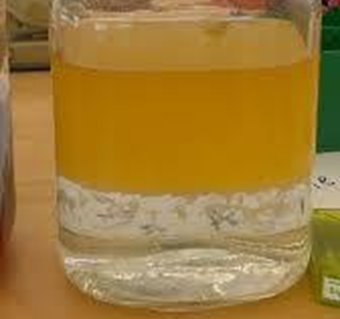Evaluation of Emulsions

Evaluation of Emulsions
Learning Objectives
At the end of this lecture, student will be able to
• Identify instabilities in emulsions and suggest suitable remedial measures
• Explain the various methods used for evaluation of emulsions
Instabilities in Emulsions
Instabilities seen in emulsion can be grouped as:
1. Cracking
2. Creaming
3. Phase inversion
1. Creaming
• Separation of an emulsion into 2 regions
• One region is richer in the disperse phase than the other
• Not a serious instability
• Uniform dispersion on shaking
• But creaming can lead to cracking
Types of Creaming
1. Upward creaming
2. Downward creaming
1. Upward creaming
– If the disperse phase is less dense than the continuous phase
– The velocity of sedimentation becomes negative
– Seen in O/W emulsions
2. Downward creaming
– If the internal or disperse (aqueous) phase is heavier than the external or continuous (oil) phase
– The globules settle
– Seen in W/O emulsions
Factors governing creaming
Stoke’s law is used to express the velocity of sedimentation
where,
V = velocity in cm/sec {rate of creaming}
r = radius of the globules
d = diameter of the globules in cm
Ps = density of dispersed phase
Po = density of dispersion medium
g = gravitational constant
n= viscosity of the dispersion medium
Causes of Creaming
• Increase in the diameter of the globules.
• Decrease in the viscosity of the external or continuous phase.
• Increase in density differences between the disperse phase and dispersion medium.
• Variations in storage temperature
Can the emulsion be saved?
• The emulsion will reform on shaking.
• Reversible process
• But creaming can lead to cracking
Prevention of Creaming
• Decreasing the diameter of the oil globules — homogenization
• Increasing the viscosity of the external / continuous phase — addition of a thickening agent.
• Reduction in density differences between the 2 phases— using phases which have similar density
•Storage in a cool place
2. Cracking
• Globules of the disperse phase coalesce and separate into a different layer
• Redispersion cannot be achieved by shaking
• The preparation is no longer an emulsion.
Causes of Cracking
1. Addition of emulsifying agents of the opposite type:
Soaps of monovalent metals – O/W emulsions and soaps of divalent metals – W/O emulsions.
2. Gums, proteins – gelatin & casein are insoluble in alcohol – if alcohol is added, the emulgent is precipitated – cracking occurs.
3. Decomposition of the emulsifying agent due to microbial action
4. Addition of common solvent
5. Oil is Rancid
6. Change of storage temperature
Can the emulsion be saved?
• The emulsion will not reform on shaking
• It is an irreversible process.
Prevention of Cracking
• Choose the correct emulsifying agent
• Avoid use of common solvent
• Use of preservatives
• Maintain constant temperature conditions for storage
• Use fresh oil for preparation
3. Phase Inversion
• Oil-in-water emulsion changes to a water-in-oil emulsion
or
• Water-in-oil emulsion changes to oil-in-water emulsion.
Causes of Phase Inversion
• Addition of the wrong emulsifying agent
E.g. If calcium chloride is added to an O/W emulsion stabilized by sodium soap, phase reversal may occur resulting in W/O emulsion.
• Increase in concentration of disperse phase beyond 60%
Can the emulsion be saved?
• The emulsion will not reform on shaking
• It is an irreversible process
Prevention of Phase Inversion
• Using the proper emulsifying agent in adequate concentrations
• Maintaining the concentration of dispersed phase between 30 to 60 %
• Storing the emulsion in a cool place.
Evaluation of Emulsions
1. Macroscopic examination: Calculating the volume of the creamed or separated part of the emulsion to the total volume.
2. Globule size analysis- By microscopic examination / electronic particle counting devices such as coulter counter / by Laser diffraction.
3. Viscosity changes: Brookefield’s Viscometer.
Preservation of Emulsions
1) Preservation from microorganisms: Use suitable preservatives
2) Preservation from oxidation: Use anti- oxidants
Labeling for Emulsions
SHAKE WELL BEFORE USE
Summary
1) Instabilities in emulsions
– Creaming: Separation of an emulsion into 2 regions and one region is richer in the disperse phase than the other
– Cracking: Separation on an emulsion into two separate layers
– Phase Inversion: Conversion of O/W emulsion into W/O emulsion and vice versa
2) Preservation of emulsions- Using preservatives
3) Labeling of emulsions- Shake Well Before Use
Also, Visit:
B. Pharma Notes | B. Pharma Notes | Study material Bachelor of Pharmacy pdf


